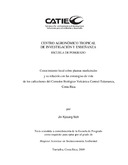| dc.description.abstract | En el presente estudio se analizó el conocimiento de los productores de café del Corredor Biológico Volcánica Central-Talamanca, Costa Rica sobre plantas medicinales asociadas a cafetales, y su relación con las estrategias de vida de los caficultores. Se entrevistaron un total de treinta y dos caficultores, considerando variables como el área del cafetal, el sistema de Producción (orgánico vs convencional), el género, su nivel del ingreso, y ubicación de la finca con respecto a altitud y distancia entre la vivienda y el cafetal. Se observó una correlación positiva entre el conocimiento en plantas medicinales y la presencia de plantas medicinales en los cafetales del CBVCT, por la visión del productor de que otras plantas en el cafetal pueden afectar la productividad del café. Pero si se observó que algunos aspectos de este conocimiento tienen una influencia directa sobre los capitales humano, cultural, social, financiero y político, que fortalecen las estrategias de vida de los caficultores del CBVCT. Se recomienda establecer planes de manejo para las especies más promisoras en tradición de uso y permitir un aprovechamiento sostenible de este recurso enfocando en las caficultoras pequeñas y orgánicas. The present study analyzed knowledge of coffee farmers in the Cordillera Volcánica Central Talamanca Biological Corridor (Central Volcanic Ridge-Talamanca Biological Corridor: CVRTBC), Costa Rica, about coffee-associated medicinal plants and their relation with coffee farmers’ livelihood strategies. Thirty-two farmers were interviewed considering variables such as total area of coffee plantations, production systeMON (organic and conventional), farmers’ gender, income level and farm location with respect to elevation and distance between homes and coffee plantations. However, a positive correlation between the knowledge on medicinal plants and the presence of medicinal plants in the coffee plantations of the CVRTBC was observed due to the producer’s vision that other plants in the coffee plantation can affect coffee productivity. Nevertheless, it was observed that some aspects of this knowledge have a direct influence on the human, cultural, social, financial and political capitals fortifying coffee farmers’ livelihood strategies of the CVRTBC. It was recommended to establish handling plans for the promissory species with traditional use, and to allow a sustainable use of this resource focusing on the small and organic coffee farmers | es_ES |


